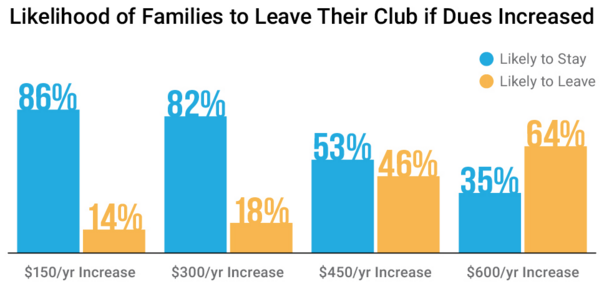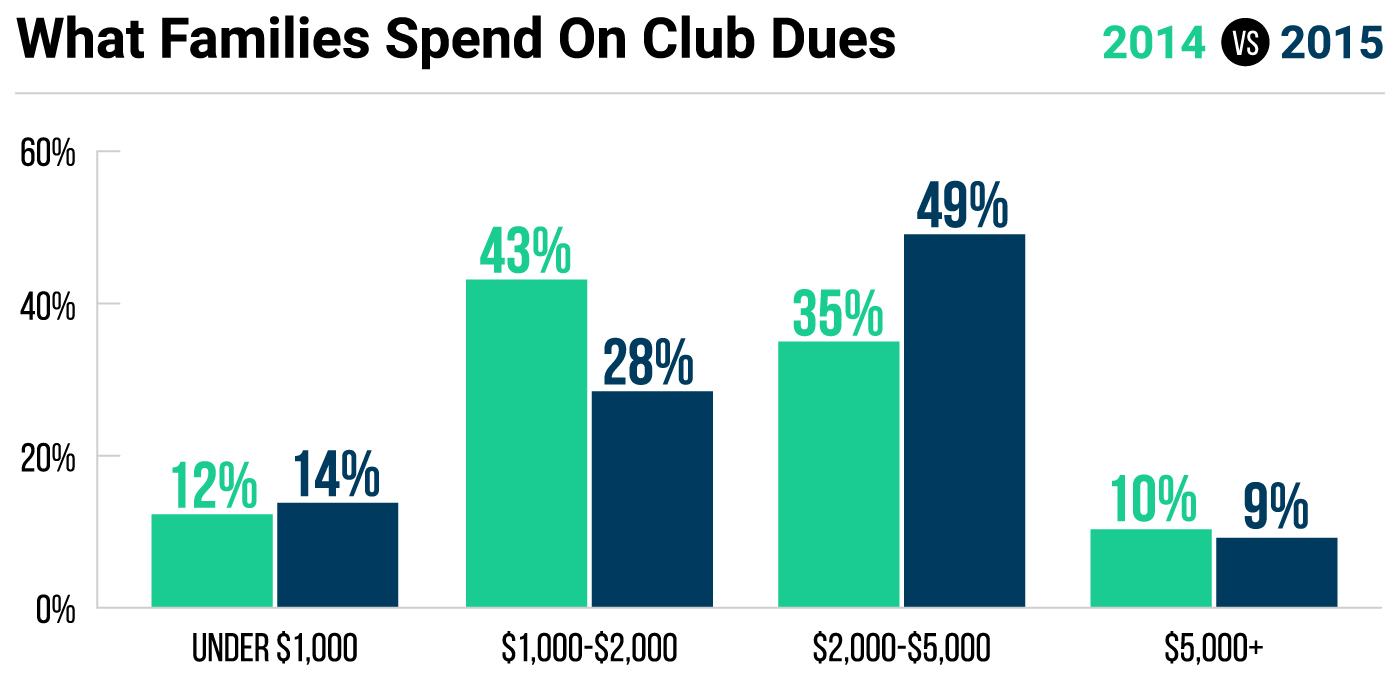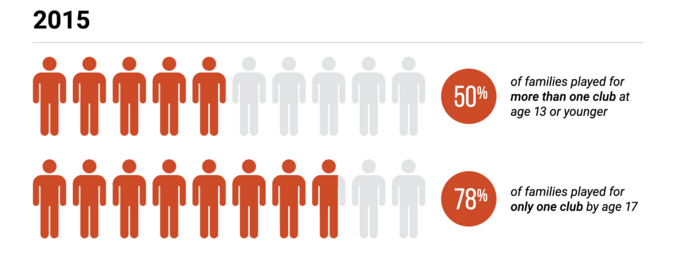Introduction
In the past two years, SportsRecruits has conducted two surveys of its members in order to better understand the club sports experience from the perspective of the family.
All responses were voluntary, and users were not required to answer each question, as our goal was and continues to be educational. The results of these surveys were very interesting and insightful (you can read them for 2104 here; and for 2015 here).
With two years worth of data now available, we decided to compare and contrast the answers in order to see if there are any noticeable trends or noteworthy consensuses on specific topics.
You can read our findings below.
Summary
Here are the three trends we explore in further detail:
- The effect of price on the decision making of club families, and how spending habits on club sports have evolved in the past year.
- Playing for multiple club teams, and how these habits change over time as student-athletes mature.
- The continued reliance on coaching and recruiting expertise as determinant factors for families choosing club sports organizations.
The Price Factor
Price is a hot topic in the world of recruiting. As club dues, travel expenses and event fees add up, so too does the discussion about how much money is being spent.
The conversation around price tends to be somewhat speculative in nature, as it relies mostly on anecdotal evidence and varies greatly by sport.
To add to this discourse intelligently, we thought it more prudent to go directly to the source: The club families ultimately making the spending decisions. In conducting surveys of club families on our platform, a few trends began to emerge.
When choosing which club to affiliate with, families selected price as the least determinant factor in both years of our survey. In 2014, 1.75% selected price as the main factor for choosing a club team, while in 2015 this rose slightly to 2%.
Wait… Families don’t care about price?
While price is certainly on the minds of families, it is interesting to see that in terms of decision making, families still look to other factors – things including coaching expertise and recruiting assistance – ahead of price.
We found this data point interesting, and decided to extrapolate it for further clarity. At what point would price increases mean reconsidering club membership? Our hypothesis was that surely a ceiling exists when it comes to paying for club sports.
We asked families how likely they were to leave their club given a series of incremental raises in their clubs dues.
As you can see, it took until a $450 raise in dues for close to a majority (46%) to be likely to leave their club. Raises of $150 and $300 did not move the needle significantly.
This aligns well with the previous point that price is not the most important factor on the minds of club families. It took a very substantial raise in prices (nearly $500) for families to indicate they were likely to leave their club.
These points beg the larger question: What are club families spending annually in club dues?
In 2014, 43% of families fell into the annual $1,000-$2,000 spending bucket. In 2015, the percentage of families in that spending bucket dropped by 15% to 28%.
There was a corresponding increase in the next price tier, where families spend $2,000-$5,000 per year on club dues. That price bucket saw a 14% increase, from 35% in 2014 to 49% in 2015.
A price migration is occurring, where families are spending more than they were even one year ago on club dues. For clubs, this means the continual focus should be on the value they are providing for their families.
Per these results, nominal increases in price have not driven families from their clubs, meaning there is room when it comes to adding value for families, even if it means slightly raising prices.
Customer Loyalty: Playing for Multiple Club Teams
Increasing competition in the club sports space has left families with no shortage of options when it comes to selecting the organization they would like to join.
Given these options, in our 2014 survey we asked club families if they would ever consider (or had previously) switched clubs.
47.96% of families said they have or would consider switching club teams, a number that represents nearly half of the respondents. That number should be fairly startling to anyone in a club organization.
In our 2015 survey, we decided to press the issue, asking how many club teams families play for.
The results:
At ages 13 and younger, 50% of families are playing for more than one club, while by age 17, 78% are playing for only one club.
Both data points say that families are not afraid to make a change in club teams if their value is not perceived to be high enough.
It also suggests families are using younger age groups to find an organization that best fits their needs before playing for one exclusively.
One can logically assume that in between these two points, a family is choosing to settle with one club organization as they enter the important recruiting years (among a variety of other factors).
This places some empirical evidence on a broadly accepted business truism: Customer loyalty is very important. It is readily apparent that younger student-athletes play for multiple club teams, while their high-school aged counterparts play for only one.
Clubs should ensure they are building loyalty with their families from a young age, as losing members can have very negative effects on an organization, even if they are replaced the next tryout cycle. While it feels like simply replacing the family with another solves the problem, in reality, there is much being left on the table.
Coaching & Recruiting Are Vital
In both our 2014 and 2015 surveys, we asked club families to select the most important factor in their decision to join a club sports organization.
In 2014, 59.275% of families selected coaching/recruiting as their determinant factor. In 2015, 82% selected coaching/recruiting assistance combined (Coaching: 58%; Recruiting 24%)
This represents a 22.73% increase in respondents relying on these two factors when choosing their club. Per the numbers, families are choosing clubs mainly for their expertise in coaching and recruiting.
What does this mean for clubs? Roughly 80% of families choose their clubs for coaching and/or recruiting, prioritizing these two facets would be wise. As competition in the club space intensifies, clubs that can prove they can provide superior coaching and recruiting expertise will thrive.
Think your club already has these locked up? Think again. It is no longer simply enough to say an organization prioritizes these two areas covered. When families are considering your club, you should be able to tangibly provide quantitative evidence demonstrating excellence.
Families need to know your club has a history of success, that your club will focus on their individual goals and that your club has the resources to get them where they want to go.
Conclusion
There is no better way to gauge what families are looking for in their club sports experience than by asking them. In our annual surveys the past two years, the trends that have emerged suggest clubs have financial room to make improvements, should focus on customer loyalty and should prioritize coaching and recruiting as tenants of their organizational model.
[ecko_contrast]
Not the right sport?
- I’m looking for SportsRecruits
[/ecko_contrast]








